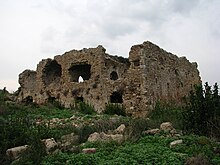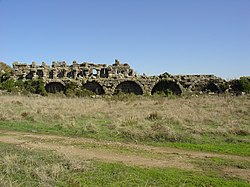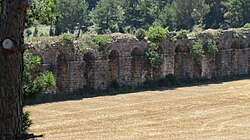Side, Turkey
 The Temple of Apollo is located at the end of Side's peninsula. | |
| Location | Antalya Province, Turkey |
|---|---|
| Region | Pamphylia |
| Coordinates | 36°46′00″N 31°23′20″E / 36.76667°N 31.38889°E |
| Type | Settlement |
| History | |
| Founded | 7th century BCE |
| Cultures | Greek, Roman, Byzantine |
| Site notes | |
| Condition | In ruin |

Side (formerly Selimiye) is a city on the southern Mediterranean coast of Turkey. It includes the modern resort town and the ruins of the ancient city of Side, one of the best-known classical sites in the country. Modern Side is a neighbourhood of the municipality and district of Manavgat, Antalya Province, Turkey.[1] Its population is 14,527 (2022).[2] Before the 2013 reorganisation, it was a town (belde).[3][4] It lies near Manavgat, 78 km from Antalya.[5]
It is located on the eastern part of the Pamphylian coast, which lies about 20 km east of the mouth of the Eurymedon River. Today, as in antiquity, the ancient city is situated on a small north-south peninsula about 1 km long and 400 m across.
History
Pseudo-Scylax,[6] Strabo and Arrian[7] record that Side was founded by Greek settlers from Cyme in Aeolis, a region of western Anatolia. This most likely occurred in the 7th century BC. A basalt column base from the 7th century BC found in the excavations and attributable to the Neo-Hittites is evidence of the site's early history.
Possessing a good harbour for small craft, Side's natural geography made it one of the most important trade centres in the region.
Its tutelary deity was Athena, whose head adorned its coinage.
Excavations have revealed several inscriptions written in the language of Side. The inscriptions, dating from the 3rd and 2nd centuries BC, remain undeciphered, but testify that the local language was still in use several centuries after colonisation.
Macedonian Rule


Alexander the Great occupied Side without a struggle in 333 BC. Alexander left only a single garrison behind to occupy the city. This occupation, in turn, introduced the people of Side to Hellenistic culture, which flourished from the 4th to the 1st century BC. After Alexander's death, Side fell under the control of one of Alexander's generals, Ptolemy I Soter, who declared himself king of Egypt in 305 BC. The Ptolemaic dynasty controlled Side until it was captured by the Seleucid Empire in the 2nd century BC. Yet, despite these occupations, Side managed to preserve some autonomy, grew prosperous, and became an important cultural centre.
In 190 BC a fleet from the Greek island city-state of Rhodes, supported by Rome and Pergamum, defeated the Seleucid King Antiochus the Great's fleet, which was under the command of the fugitive Carthaginian general Hannibal. The defeat of Hannibal and Antiochus the Great meant that Side freed itself from the overlord-ship of the Seleucid Empire.
Post-Seleucid Rule

The Treaty of Apamea (188 BC) forced Antiochus to abandon all European territories and to cede all of Asia Minor north of the Taurus Mountains to Pergamum. However, the dominion of Pergamum only reached de facto as far as Perga, leaving Eastern Pamphylia in a state of uncertain freedom. This led Attalus II Philadelphus to construct a new harbour in the city of Attalia (the present Antalya), although Side already possessed an important harbour of its own. Between 188 and 36 BC Side minted its own money, tetradrachms showing Nike and a laurel wreath (the sign of victory).
In the 1st century BC, Side reached a peak when the Cilician pirates established their chief naval base and a centre for their slave-trade.
Romans


The consul Servilius Vatia defeated these brigands in 78 BC and later the Roman general Pompey in 67 BC, bringing Side under the control of Rome and beginning its second period of ascendancy, when it established and maintained a good working relationship with the Roman Empire.[8]
Emperor Augustus reformed the state administration and placed Pamphylia and Side in the Roman province of Galatia in 25 BC, after the short reign of Amyntas of Galatia between 36 and 25 BC. Side began another prosperous period as a commercial centre in Asia Minor through its trade in olive oil. Its population grew to 60,000 inhabitants. This period would last well into the 3rd century AD. Side also established itself as a slave-trading centre in the Mediterranean. Its large commercial fleet engaged in acts of piracy, while wealthy merchants paid for such tributes as public works, monuments, and competitions as well as the games and gladiator fights. Most of the extant ruins at Side date from this period of prosperity.
Side was the home of Eustathius of Antioch, of the philosopher Troilus, of the fifth-century ecclesiastical writer Philip; of the famous lawyer Tribonian.[9]
Decline
Side began a steady decline from the 4th century on. Even defensive walls could not stop successive invasions of highlanders from the Taurus Mountains. During the 5th and 6th centuries, Side experienced a revival, and became the seat of the Bishopric of Eastern Pamphylia. Arab fleets, nevertheless, raided and burned Side during the 7th century, contributing to its decline. The combination of earthquakes, Christian zealots and Arab raids, left the site abandoned by the 10th century, its citizens having emigrated to nearby Attalia.[8]
In the 12th century, Side temporarily established itself once more as a large city. An inscription found on the site of the former ancient city shows a considerable Jewish population in early Byzantine times. However, Side was abandoned again after being sacked. Its population moved to Attalia, and Side became known as Eski Adalia 'Old Antalya' and was buried.
Ecclesiastical history
As capital of the Roman province of Pamphylia Prima, Side was ecclesiastically the metropolitan see. The earliest known bishop was Epidaurus, presiding at the Synod of Ancyra, 314. Others are John, fourth century; Eustathius, 381; Amphilochius, 426-458, who played an important part in the history of the time; Conon, 536; Peter, 553; John, 680-692; Mark, 879; Theodore, 1027-1028; Anthimus, present at the synod held at Constantinople in 1054; John, then counsellor to the Emperor Michael VII Ducas, presided at a council on the worship of images, 1082; Theodosius and his successor Nicetas, twelfth century. John, present at a synod at Constantinople in 1156. The Notitiae Episcopatuum continued to mention Side as a metropolis of Pamphylia until the thirteenth century. It does not appear in the "Notitia" of Andronicus III. In 1397 the diocese was united with that of Attalia; in 1400 the Metropolitan of Perge and Attalia was at the same time the administrator of Side.[10][citation needed]
No longer a residential see, Side is today included in the Catholic Church's list of titular sees.[11]
Monuments and Site
The great ruins are among the most notable in Asia Minor. They cover a large promontory which a wall and a moat separate from the mainland. Archaeologists have been excavating Side since 1947 and intermittently continue to do so.[12]
The colossal theatre complex of the 2nd century is less well-preserved that of Aspendos, but it is almost as large, seating 15,000–20,000 people. It was converted into an open-air sanctuary with two chapels during Byzantine times (5th or 6th century).
The well-preserved city walls provide an entrance to the site through the Hellenistic main gate (Megale Pyle) from the 2nd century BC.
The colonnaded street had marble columns whose remains can be seen near the Roman baths, restored as a museum displaying statues and sarcophagi from the Roman period. The agora includes the remains of the round Tyche and Fortuna temple (2nd century BC), peripteral with twelve columns, in the centre. In later times it was used as a trading centre where pirates sold slaves.
The early Roman Temple of Dionysus is near the theatre. The fountain gracing the entrance is restored. At the left side is a Byzantine Basilica.[8]
Other buildings include three temples and a nymphaeum, a grotto or fountain building of elaborate design, and a synagogue which was discovered under a modern place of residence.[13]
Excavation teams also found an ancient Greek brothel.[14]
The aqueduct


The Roman aqueduct dates from 2nd half of the 2nd century AD and is 30 km in length. The aqueduct is special because it has an exceptional number of bridges which are still preserved as well as tunnels. This was because the altitude difference between source and city is only 36 m, so to make the gradient as high as possible it was necessary to keep the route as straight and short as possible through the hilly terrain, which entailed more expensive bridges (22 in total) and 16 tunnels 100-2260m long.
It was restored in the first half of the 3rd century, financed by Lollianos Bryonianos from Side according to an inscription.
Today

In 1895, Turkish Muslim Immigrants from Crete moved to the area of the ruins and called it Selimiye; they also built houses over the ruins when the Cretan Turks moved there.[15][16][17] Today, Side has become a popular holiday destination as a result of the expansion of the Antalya coastal project and is experiencing a revival.
It was a popular spot for watching the solar eclipse of March 29, 2006.
The bustling street called Liman Caddesi connects the town bus station with the square on the seafront, where the statue of Atatürk is situated.[18]
Notable people
- Marcellus of Side, an ancient physician
- Troilus (philosopher), a sophist
- Tribonian, a famous Byzantine jurist and advisor
- Callistus of Side, Olympic winner at Stadion race[19]
- Eustolus of Side, Olympic winner at Stadion race[19]
- Ruzi Nazar, Uzbek CIA officer active in Turkey during the 1960s; retired and died in Side [20]
See also
- Coinage of Side
- Manavgat Waterfall
- Oymapinar Dam
- Philip of Side
- Saint Probus of Side
- Sidetic language
Notes
- ^ Mahalle, Turkey Civil Administration Departments Inventory. Retrieved 22 May 2023.
- ^ "Address-based population registration system (ADNKS) results dated 31 December 2022, Favorite Reports" (XLS). TÜİK. Retrieved 22 May 2023.
- ^ "Law No. 6360". Official Gazette (in Turkish). 6 December 2012.
- ^ "Classification tables of municipalities and their affiliates and local administrative units" (DOC). Official Gazette (in Turkish). 12 September 2010.
- ^ "The Ancient Library". Archived from the original on 2007-05-13. Retrieved 2006-11-19.
- ^ Pseudo Scylax, Periplous, 101
- ^ Arrian, The Anabasis of Alexander, book I, chapter XXVI, 4
- ^ a b c "Side - History of the City". Archived from the original on 2006-11-14. Retrieved 2006-11-19.
- ^ Catholic Encyclopedia, 1907-1912, s.v. 'Sidon'
- ^ This section contains text from the Catholic Encyclopedia of 1907-1912, a work in the public domain
- ^ Annuario Pontificio 2013 (Libreria Editrice Vaticana, 2013, ISBN 978-88-209-9070-1), p. 971
- ^ "Aspendos - Perge - Side". Retrieved 2006-11-19.
- ^ "7th-century synagogue found under house - Türkiye News".
- ^ Turkish archaeologist complains after sponsors refuse to fund brothel excavation
- ^ [1] From link: In 1895 Turkish people from Crete moved to the ruined town and called it Selimiye.
- ^ [2] Archived 2011-05-14 at the Wayback Machine Side Travel Guide
- ^ "Side, Turkey". Archived from the original on 2011-06-29. Retrieved 2010-12-30. Turkish Riviera - Side
- ^ "The town of Side, July 2017". Independent Travellers. independent-travellers.com. Retrieved May 23, 2018.
- ^ a b Eusebius, Chronography, 81
- ^ "Central Asian Cold Warrior Ruzi Nazar Dies In Turkey". Radio Free Europe. 4 May 2015. Retrieved 2022-06-04.
External links
 Media related to Side at Wikimedia Commons
Media related to Side at Wikimedia Commons
- Hazlitt, Classical Gazetteer, "Side"
- Acceptable pictures of the museum, 105 of them
- Amateur pictures of the town of Side
- Photo of basalt Neo-Hittite column base found at Side.
This article incorporates text from a publication now in the public domain: Chisholm, Hugh, ed. (1911). "Side". Encyclopædia Britannica (11th ed.). Cambridge University Press.

